Easy Astronomy Targets for Binoculars
Binoculars are an excellent way for beginners and experienced astronomers to explore the night sky.
Their ability to gather more light than the naked eye will reveal a whole host of new stars, planetary moons, deep sky objects and lunar features to you.
Combined with some modest magnification binoculars bring you that little bit closer to the wonders of the night sky.
Contents
1. Can you Stargaze with Binoculars?
2. The Moon
3. Jupiter Through Binoculars
4. Constellations of Cassiopeia and Perseus
5. The Pleiades (M45)
6. Andromeda Through Binoculars
7. The Orion Nebula (M42)
8. Saturn Through Binoculars
Star charts in this post were generated by Starry Night Enthusiast 8 © Copyright Simulation Curriculum Corp. All rights reserved. www.starrynight.com
Can you Stargaze with Binoculars?
Yes, binoculars will drastically improve your view of the night sky. Here is a quick summary of why binoculars are excellent for astronomy.
- More light-gathering power than the naked eye. A pair of binoculars with 50 mm objective lenses can gather up to 70 times more light than the naked eye.
- A wide field of view compared to a telescope makes finding things much easier.
- Great way to learn how to hop between stars and constellations.
- Good eye relief and a large exit pupil, i.e. no squinting and using both eyes provide comfortable viewing, even for spectacle wearers.
- A cost-effective next step for beginners.
- Binoculars produce an upright image so they can also be used to view everyday scenes, simply point them at what you want to view.
- Binoculars are a perfect way for those of you who are new to stargazing to become more familiar with the night sky.
The chances are you may already own a pair of binoculars, perhaps they have been stored away in a cupboard or garage, if you do then dust them off and give them a try under the next clear sky.
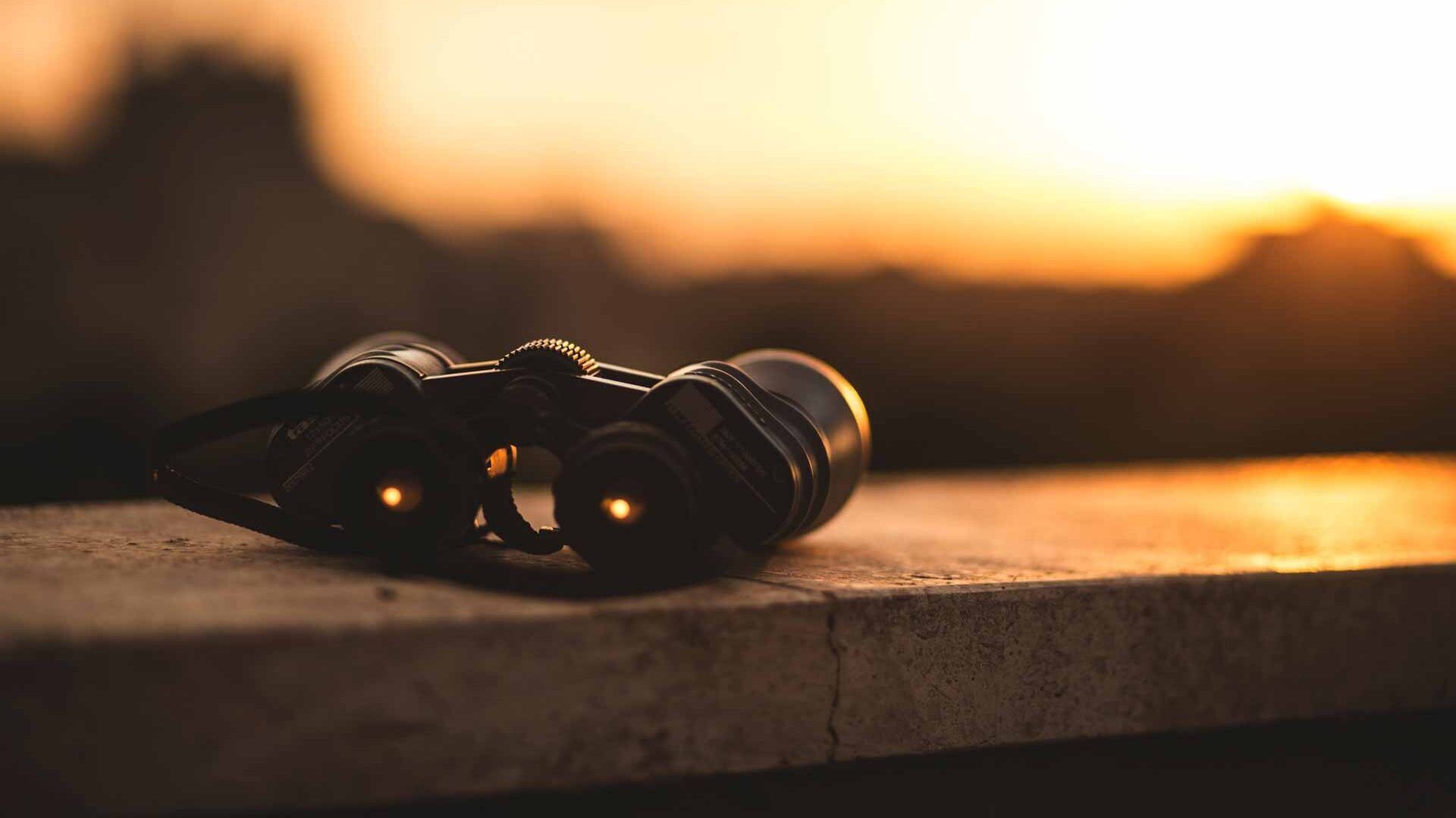
Binoculars are a great way to get into astronomy, Public domain
Handheld vs Tripod Mounted
All of the objects in this list can be viewed by simply holding the binoculars securely in your hands.
This is a convenient way to scan the night sky and is particularly useful if you don’t have much time or are at a remote location and don’t want to carry a heavy tripod with you.
Where possible rest your elbows on a firm surface, such as a table or a fence, this extra stability will help to minimise any unwanted hand movement.
If you own a tripod, then I recommend mounting the binoculars to them. Most binoculars have a tripod adapter thread and are typically light enough that a sturdy photographic tripod can securely hold them.
To mount the binoculars to a tripod, a simple L-bracket adapter will be required. This screws into the front of your binoculars and allows you to mount them directly onto a tripod, or onto a removable tripod shoe.
Using a tripod ensures the image you see is stable, allowing you to appreciate and study the astronomical objects that you view.
The Moon
The Moon is an obvious astronomy target for binoculars. Its regular 28-day cycle is easy to follow, and observing its features during the different phases is great to watch through binoculars.
You can find out the current moon phase using this Moonrise, Moonset, and Moon phases calendar.
During the early phases of the Moon, just after a New Moon, it will be a thin crescent low in the evening sky after sunset. This phase is a great time to see what is known as Earthshine.
Earthshine is when light from the Sun reflects off the Earth’s atmosphere onto the Moon’s surface. This light dimly illuminates the otherwise unilluminated portion of the Moon’s surface.
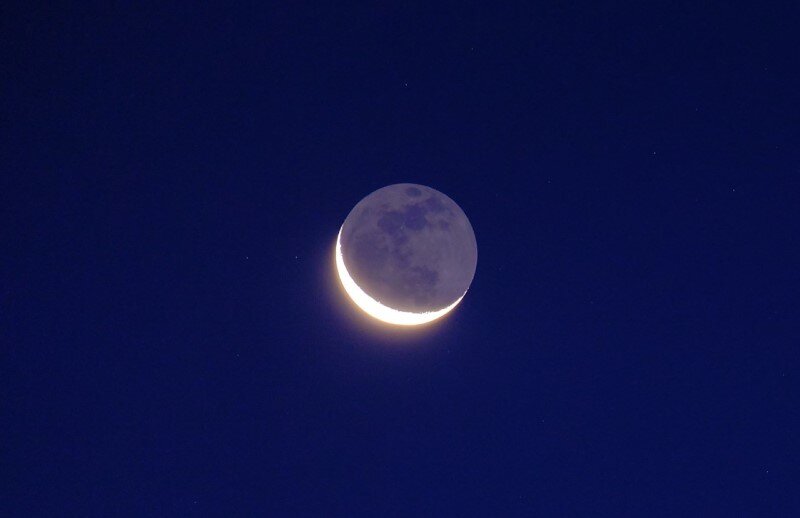
Earthshine, by taro96b CC BY-ND 2.0
When viewed using binoculars, the Earthshine can be quite striking, giving the Moon’s surface a cool blue-grey hue. There is usually enough illumination to allow you to observe surface features.
As the Moon progresses through its phases, you should look along the boundary between the dark and light areas on the Moon’s surface. The Sun casts long shadows in this area, making the lunar features appear more clearly.
This boundary is known as the terminator, and as the Moon progresses through its phases, different features along this line will gain prominence each night.
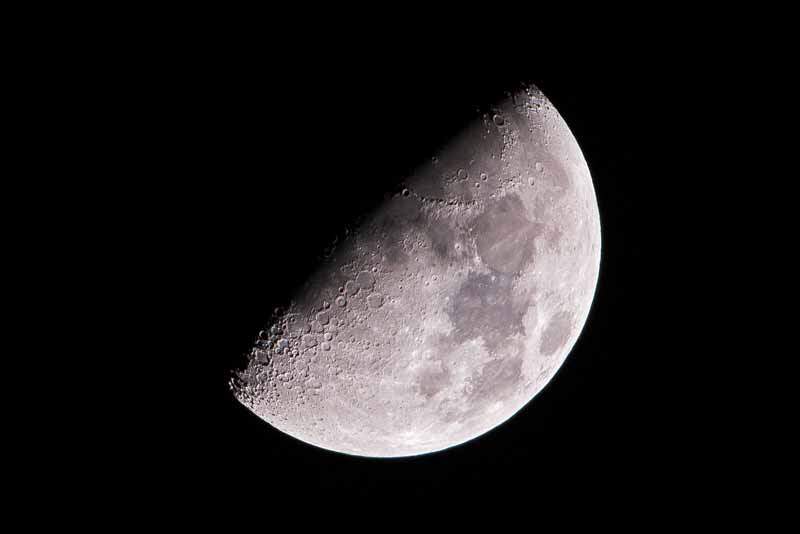
Features along the terminator are much more pronounced CC BY 2.0
As the Moon approaches its Full phase, its brightness can be a bit overpowering when viewed through binoculars, particularly if your eyes are dark-adapted.
During a full Moon, you are no longer able to see the detail of the craters and mountain regions as clearly, due to the angle that the Sun is striking the Moon’s surface. However, the contrast of the dark flat lunar maria (or lunar seas) against the lighter highland regions can be enjoyed and enhanced through binoculars.
Jupiter Through Binoculars
Jupiter is the largest planet in the Solar System, and I feel that it has a lot to offer to the binocular observer.
At the time of writing this post, Jupiter is low down in the southwestern part of the sky after dark. It is hard to miss, look in a south-westerly direction, and you will spot a bright object, this is Jupiter.
When you look at Jupiter through binoculars the first thing that you will notice once brought into focus is that it is more than just a bright object, you will be able to decern its planetary disc. It will appear as a small bright ball through a pair of 10 x 50 binoculars.
With closer inspection, you will see some small points of light on one or both sides of Jupiter’s bright disc. These are Jupiter’s moons! Jupiter has dozens of moons, and you can spot its four biggest: Io, Europa, Ganymede, and Castillo through binoculars.
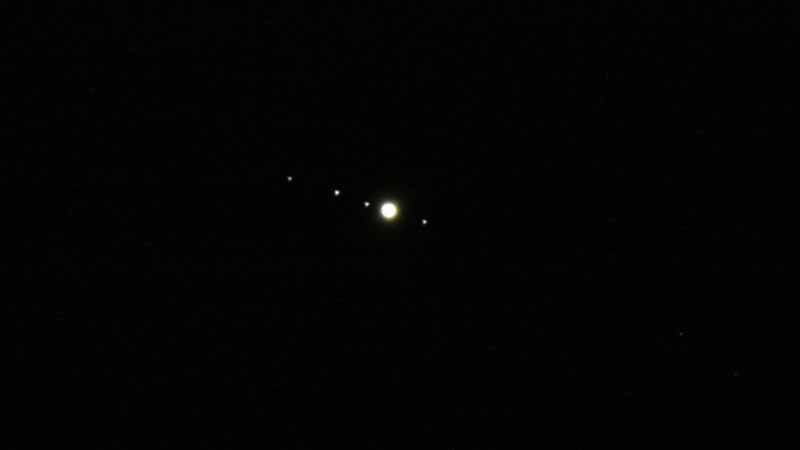
Spotting Jupiter’s moons is absolutely possible with a pair of binoculars CC BY-SA 4.0
One evening you may be able to see all four of these moons strung out like tiny jewels on one side of Jupiter. Another evening perhaps you will only see one or two.
Watching Jupiter’s moons dance around from night to night and monitoring their positions is a great activity for beginners and experienced astronomers alike.
Constellations of Cassiopeia and Perseus
An especially rich section of our Milky Way Galaxy runs through the constellations of Cassiopeia and Perseus.
Rich star fields, open clusters, and deep-sky objects fill this area of the sky, and it is a real pleasure to scan over with binoculars.
Find out how to locate the constellation Cassiopeia.
Amongst these star fields lies one of the night sky’s finest gems, the double cluster in Perseus. Lying about halfway between the constellations of Cassiopeia and Perseus, these two open clusters are a fantastic sight through binoculars.
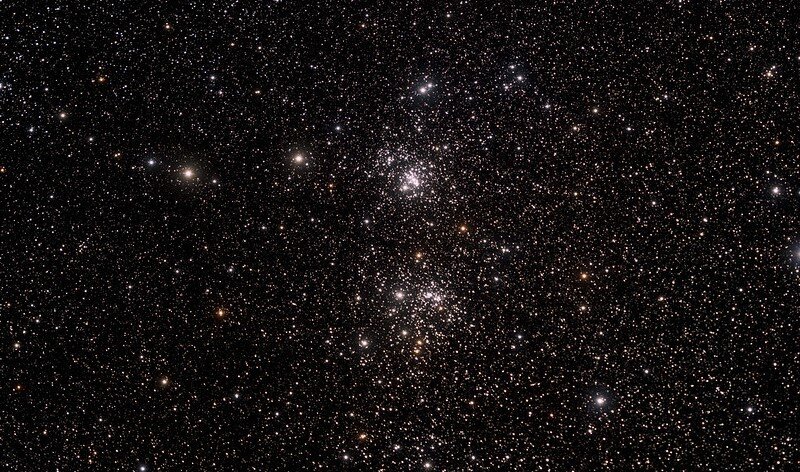
The double cluster in Perseus is an easy target for binoculars, by Stephen Rahn Public Domain
To most northern hemisphere observers the double cluster is circumpolar and can be viewed year-round from places such as the UK, northern Europe, the US, and Canada. It is best viewed high in the sky during the winter months from November to January.
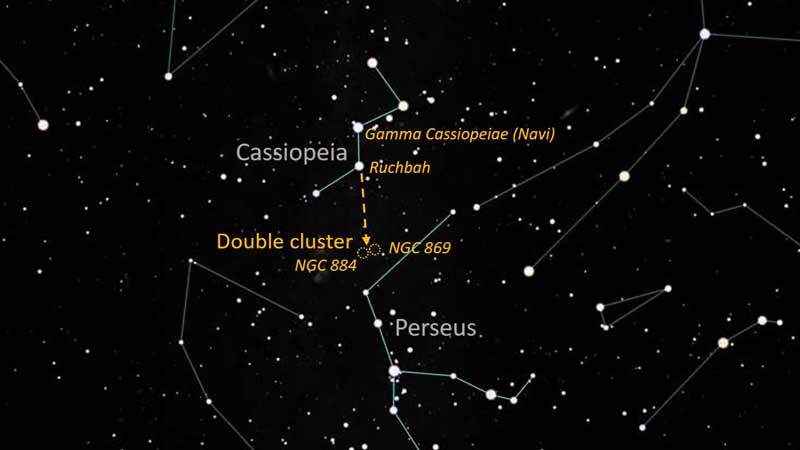
The double cluster, (NGC 884 and NGC 869) is located between the constellations of Cassiopeia and Perseus.
Although the clusters are officially located in the constellation Perseus the easiest way to locate them is to start from the constellation of Cassiopeia. By tracing a line from the two stars Gamma Cassiopeiae and Ruchbah, you will reach the double cluster, as shown in the chart above.
The view through binoculars will reveal the two closely spaced clusters each with dozens of tightly spaced stars for you to enjoy.
The Pleiades (M45)
The Pleiades cluster contains hundreds of stars, and due to its proximity to Earth, it is one of the most spectacular open clusters in the night sky.
Also known as the Seven Sisters, the Pleiades is located in the constellation of Taurus and is easily visible to the naked eye as a small fuzzy group of stars. Under dark skies and with keen eyesight it is possible to count six to eight of these stars.
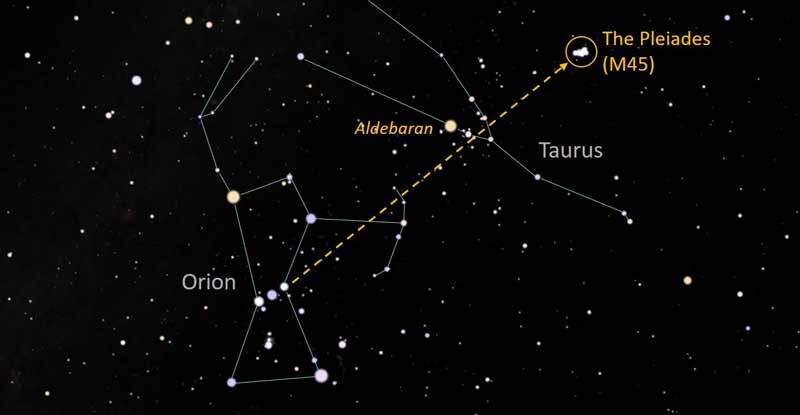
The location of the Pleiades (M45) is in the constellation Taurus.
Right now the Pleiades can be seen rising in the East in the evening, and as we move through November and December, the cluster will become more prominent in the night sky. It will be visible throughout winter and into spring.
The Pleiades clusters can be easily found by extending the line of Orion’s belt through Taurus, past the bright orange star Aldebaran and then onto the Pleiades cluster.

The Pleiades cluster is one of the most impressive astronomical objects to view through binoculars, by Carsten Frenzl CC BY 2.0
A view of the Pleiades through a pair of 10 x 50 binoculars will reveal dozens of bright blue stars. With an angular size of about two degrees, the Pleiades fits nicely into the wide field of view offered by binoculars.
Using binoculars to view the Pleiades is one of the best ways to appreciate the cluster in its entirety.
Andromeda Through Binoculars
The Andromeda galaxy is one of the brightest Messier objects in the night sky, with an apparent magnitude of 3.4 it is easily visible to the naked eye under ideal conditions. Through binoculars, it is even more vibrant and stands out very clearly against a dark background.
The Andromeda galaxy is one of my favourite binocular objects, and I recommend taking the time to become familiar with its location in the night sky.
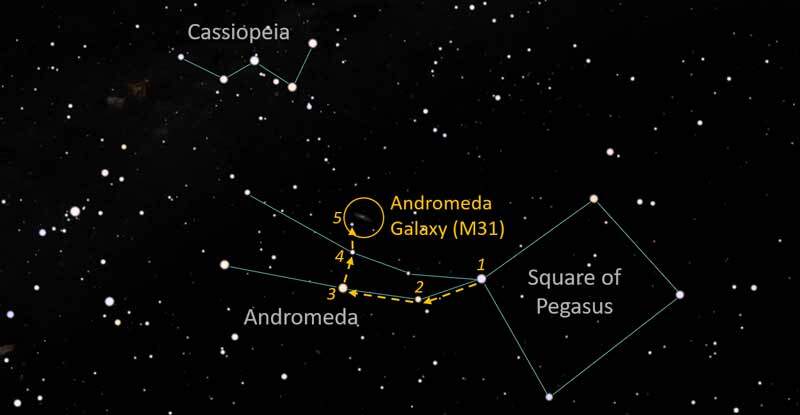
Starting from the Square of Pegasus use the star-hopping sequence from 1-5 to find the Andromeda Galaxy.
To find the Andromeda galaxy, you should first find the large asterism known as the Square of Pegasus, which joins onto the constellation of Andromeda. The chart above shows their location in relation to the more familiar constellation, Cassiopeia.
The Square of Pegasus covers a large area of the night sky that does not contain many stars, so it is easy to recognise.
If you start at the star in the top left corner of the Square of Pegasus and follow the star-hopping sequence numbered 1-5 in the chart, you will find the Andromeda galaxy.
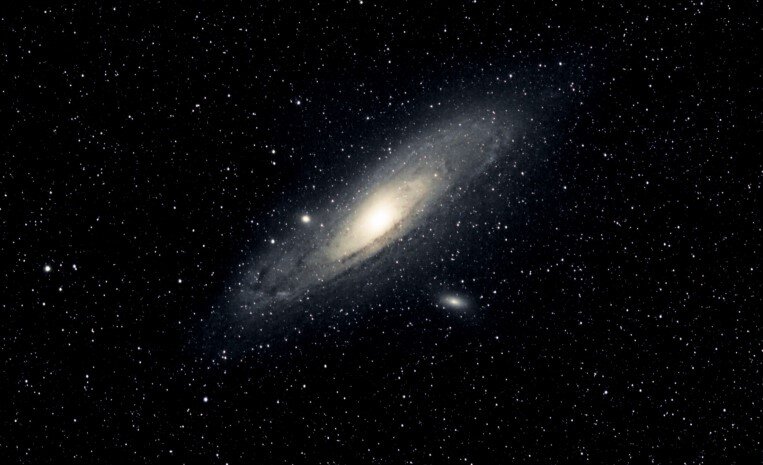
Binoculars will begin to reveal the Andromeda Galaxy to you, by Mike Soulby © stellardiscovery.com
Viewed through a pair of 10 x 50 binoculars, the Andromeda galaxy will appear as an elongated fuzzy shape with a brighter core region. When mounted on a tripod, it is possible to study the extent of this fuzziness, and using averted vision; it will ‘pop out’ even more to you.
Once spotted in binoculars it is unmistakable against the surrounding pin-point stars.
The Orion Nebula (M42)
The Great Orion Nebula is probably the most famous and easy-to-find nebula in the night sky. The constellation of Orion is an unmistakable winter constellation, and the nebula is its greatest wonder.
Located below the three stars that make up Orion’s belt, the nebula makes up part of Orion’s sword and can be easily spotted with the naked eye.
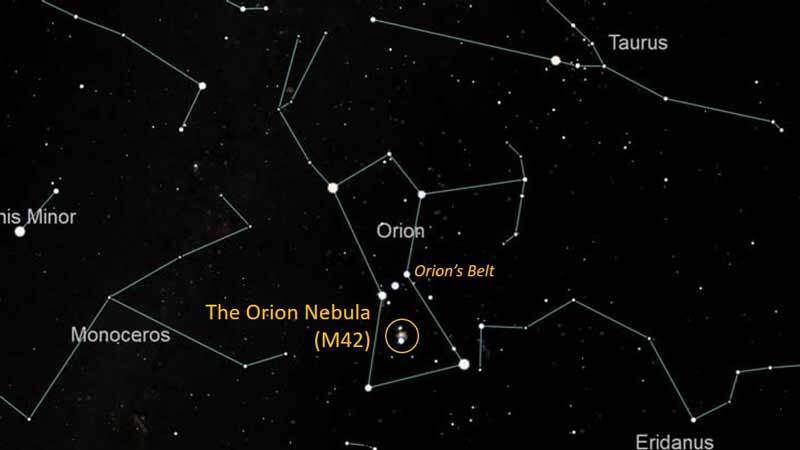
During the winter months, the Orion nebula is one of the easiest deep sky objects to find and view using binoculars.
The Orion nebula is a giant stellar nursery where new stars are being born. Located 1300 light-years away, it is one of the closest star-forming regions to Earth.
Strong ultraviolet radiation from hot young stars recently formed within the nebula energises the surrounding gas, producing the nebula’s bright glow.
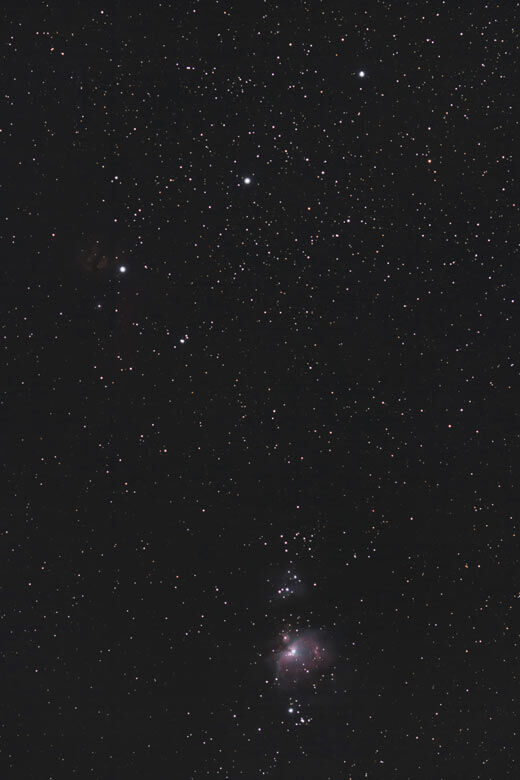
The Orion Nebula underneath the three stars of Orion’s belt, by Mike Soulby © stellardiscovery.com
Through binoculars, the nebulosity is clearly revealed as an extended cloud encompassing a small collection of stars. If you wait until the new moon phase and travel to a dark sky site away from light pollution, the Orion nebula is a real delight to behold.
Saturn Through Binoculars
Saturn is famous for its spectacular ring system; however, you will need a small telescope to be able to view them clearly. If you ever get the chance to view Saturn through a telescope, I would strongly recommend it. It is quite simply, stunning.
At the time of writing, Saturn can be seen in the evening sky, in the southwest, close to Jupiter. Over the next few weeks, Saturn and Jupiter will get closer together in the night sky, with Jupiter eventually overtaking Saturn.
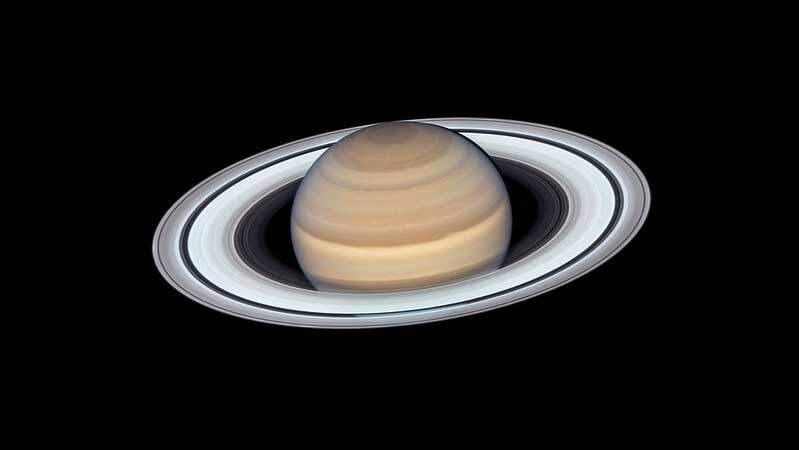
Ok I couldn’t resist, this is a fantastic Hubble Space Telescope image of Saturn, by the European Space Agency and NASA CC BY 2.0
Whilst a pair of 10 x 50 binoculars do not have a large enough aperture to resolve Saturn’s rings; they can still reveal several interesting things about the second-largest planet in our Solar System.
Due to its rings, a view of Saturn through 10×50 binoculars reveals a distinctly oval-shaped disc; the rings create what look like ears or lobes on the disc. This view is similar to how Galileo first observed Saturn in the early part of the 17th century; he describes these lobes as ‘handles’. It wasn’t until Christiaan Huygens with a better telescope later discovered the true nature of these handles as Saturn’s spectacular ring system.
Binoculars will also enhance Saturn’s pale golden colour. Saturn’s colour comes from ammonia crystals in its upper atmosphere that reflects mostly pale yellow light.
Like Jupiter, Saturn has dozens of Moons. However, binoculars will only reliably reveal its largest moon, Titan. This 8th-magnitude moon will appear as a faint point of light through binoculars.
Final words
There are many more objects that can be viewed and found using binoculars, but I hope that this list will give you several easy targets to find, learn, and enjoy.
Some other worthwhile objects within reach of binoculars that are not listed above include:
Beehive cluster (M44) in Cancer
The Coathanger asterism in Vulpecula (near Cygnus)
The globular cluster (M13) in Hercules
Epsilon Lyrae in Lyra
Hyades open cluster in Taurus
The outer planets, Uranus and possibly Neptune, are also within reach of a pair of 10 x 50 binoculars depending on local conditions. They will appear as small points of light, Uranus has a green appearance, and Neptune appears as a small blue star.
Please feel free to leave comments and suggestions below. Good luck and let’s hope for some clear cloud-free nights.
0 Comments